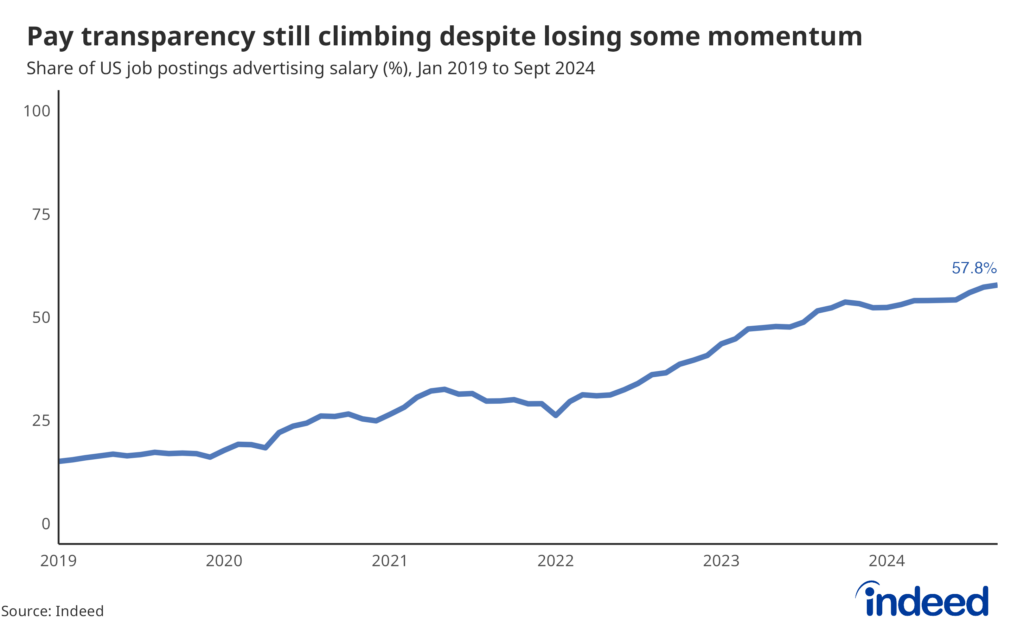Key Points:
- As of September 2024, 57.8% of all US job postings on Indeed contained some salary information, up from 52.2% in September 2023.
- Childcare, Personal Care & Home Health, and Security & Public Safety are among the sectors with the highest shares of pay-transparent postings.
- Salary transparency has grown considerably in states that recently passed laws requiring pay transparency — including New York, Hawaii, and the District of Columbia.
- Salary transparency grew in 95 of the 110 metropolitan areas included in this analysis over the past year.
Salary transparency is increasingly becoming a common feature in job postings, especially as more states pass legislation requiring it. But despite continued growth in salary transparency overall, some sectors and states remain more opaque than others when it comes to disclosing pay information.
Salary transparency continues to climb, but slowly

As of September 2024, 57.8% of job postings on Indeed listed some type of pay information, up from 52.2% in September 2023. However, the pace of pay transparency growth in 2024 has slowed compared to last year. From September 2022 to September 2023, the percentage of job postings advertising salary information climbed 15.7 percentage points.
Various factors could be causing the slowdown in salary transparency growth. For one, salary transparency laws in large states like California and New York (which account for a substantial share of US job postings), have been in effect for over a year now, leaving less incremental growth from changes to laws in smaller states. Additionally, this slowdown may be attributable to a shifting labor market. The labor market has slowed and competition for workers has eased somewhat, potentially leaving employers feeling less urgency to attract candidates by stating pay information directly in job postings.
Salary transparency grows in most sectors
Salary transparency varies widely across occupational sectors. The list of the most transparent sectors has remained largely unchanged from prior years, but there have been some changes among the ranking of the least transparent sectors.
The Childcare sector remains the most transparent, with 81.7% of postings listing salary information, up from 75.9% in February 2023. The five most transparent sectors have remained largely consistent, with the exception of Driving, which broke into the top five.
Healthcare occupations are among the least transparent sectors, with the Medical Information, Medical Technician, and Physicians & Surgeons sectors holding three of the five bottom spots. In February 2023, none of these appeared in the bottom five, indicating that some pockets of the healthcare industry may be falling behind when it comes to pay transparency.
Growth across the board
While some industries lag others in salary transparency, overall salary transparency has grown by some degree across almost every sector. Compared to a year ago, the share of salary-transparent listings grew in 43 of 46 sectors analyzed by Indeed — often by large margins.
Pharmacy job postings notched the most substantial gain in salary transparency, rising 24 percentage points between September 2023 and September 2024 (from 46.5% to 70.4%). And while salary transparency did decline in a few occupational sectors, the overall trend points up, with gains generally outweighing marginal downticks.
Legislative action drives change at the state level
Job postings on Indeed are increasingly impacted by recent salary transparency laws enacted by individual states and municipalities.
Perhaps unsurprisingly, the three states/locales with the largest gains in salary transparency over the past year — Hawaii, D.C., and New York — are those in which pay transparency legislation has also taken effect over the past year. There is, however, considerable variation in the level of salary transparency among these states. Employers in New York, for example, are highly transparent, listing salary information in almost all (97.7%) New York job postings. But job postings in the District of Columbia are significantly less transparent, listing pay information in only about two-thirds (66.5%) of postings, which could be due to the law recently coming into effect in June 2024.
Maryland is the most recent state to enact pay transparency legislation, with new laws taking effect October 1st, 2024 — just after the time frame of this analysis. Even so, transparency rose by 14.5 percentage points in Maryland between September 2023 and September 2024, indicating that employers may have made preemptive changes to become compliant even before the law took effect.
A look at the pay transparency landscape across the US reveals some clear regional differences. Pay transparency is less common across the South. In the West, a region that includes several states with existing pay transparency laws like California, Colorado, and Washington, it is generally more common for pay information to be listed in the job posting.
Metro areas
Within states, the impact of new legislation is also apparent in the list of metro areas with the largest changes in salary transparency.
Honolulu leads the list, with the share of salary-transparent listings in and around the city growing by 28.8 percentage points between September 2023 and September 2024 (from 51.7% to 80.5%). The remaining four of the top five fastest-growing salary-transparent metros are in New York state.
Salary transparency declined year-over-year in only 5 of the 110 most-populated metro areas included in this analysis. Three of the five metro areas that registered declines over this period were in the South, and all declines were 1.7 percentage points or smaller.
Conclusion
It is clear that new laws are driving up the share of job postings advertising salary information. But the labor market slowdown and easing competition for workers could weigh on employers’ urgency to remain competitive by including this information upfront in areas where it is not explicitly required by law. Whatever the local legal requirements, the benefits of stating pay information in job postings — for both employers and job seekers — are clear, no matter the condition of the labor market. For employers, transparency can help build trust with their current employees by ensuring a level playing field among similar workers, potentially helping to close gender and/or racial pay gaps, and attracting new workers seeking a specific wage. For job seekers, knowing proposed pay up front can help to calibrate expectations when it comes time to negotiate a salary, and/or can save time by helping to weed out roles where stated pay is less than expected or desired for a given role.
Methodology
We calculate pay transparency share in US job postings by dividing the number of unique job postings with a salary into a total count of unique advertisements in a given month. Pay information is extracted from postings published on Indeed.com. Salaries advertised as being paid daily or weekly are omitted from the analysis.
Metropolitan area (MSA) data is filtered based on population in 2018. MSA data is presented as a weighted share to control for regional differences in job composition. We consider an MSA fully covered under the law if it falls into a state or city with an active regulation. Additionally, we consider an MSA covered if it overlaps state lines and falls in a state with pay transparency laws. *Pay transparency may measure below 100% in areas with regulation due in part to exemptions for employers with fewer than a set number of employees, or employers of temporary help or contractors. For instance, employers with fewer than 15 employees are not required to comply with the California and Washington regulations. Additionally, some legislation, like that in New York City, provides exemptions for temporary help firms. Finally, employers may choose not to include clear salary information despite the regulations.


